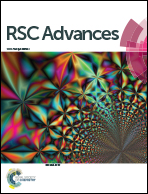TiO2 surface engineering with multifunctional oligomeric polystyrene coadsorbent for dye-sensitized solar cells
Abstract
Oligomeric, hydrophobic coadsorbents based on polystyrene (o-PS, Mn = 2600) terminated by a carboxylic acid exhibit dual functions in dye-sensitized solar cells (DSCs): suppression of electron recombination at the TiO2 surface, and enhanced concentration of the strongly-anchored dye, N719, which has two carboxylic acid groups. Engineering the TiO2 surface via o-PS results in the concurrent and significant enhancement of photovoltage and photocurrent, consequently increasing the energy conversion efficiency of DSCs by as much as 28.7%. The electron recombination rate was largely reduced via the blockage of vacant sites with o-PS chains on the TiO2 surface due to the physical hindrance to I3−s in electrolyte. In addition, the formation of the o-PS:I2 charge transfer complex at the photoanode/electrolyte interface lessened the effective concentrations of free I3− and/or I2 for electron recombination. Upon sequential o-PS coadsorption, the concentration of the strongly-anchored dyes on the TiO2 surface was increased via deprotonation of the weakly-anchored dyes, giving rise to an increase in the electron injection efficiency and, subsequently, the overall power conversion efficiency. The dual functions of the o-PS coadsorbent have been therefore demonstrated to increase the overall efficiency of DSCs.


 Please wait while we load your content...
Please wait while we load your content...